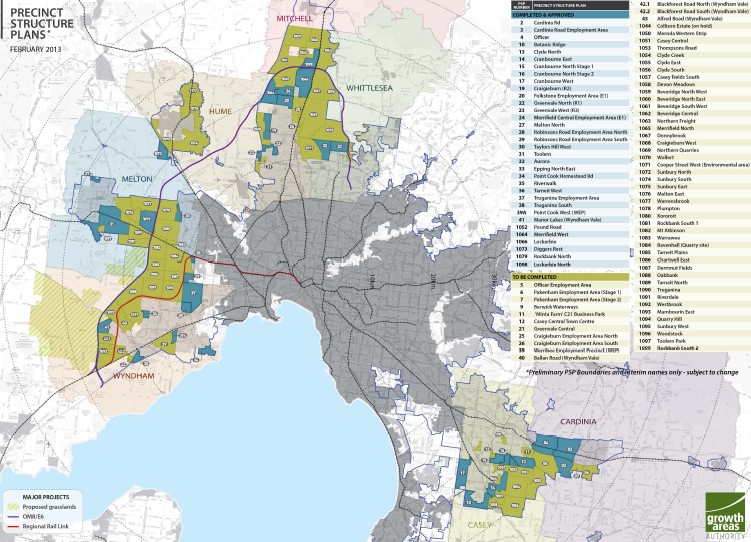
Please find below another interesting article from Prosper’s David Collyer on land banking. For David’s earlier articles on this issue, see here and here.
A fact-free defence of urban planners in The Conversation yesterday has left me fuming about how this group is immersed in process and blind to The Game being played around them.
The Game boosts land prices, creates serviced land shortages and impoverishes all who need shelter.
Planners are proud to quickly turn around conforming applications. And they eagerly engage in futile debates around ‘red tape’ which miss the point entirely.
Let us start somewhere else by considering the role of vacant land in urban areas or held ‘englobo’ nearby ahead of subdivision. Withholding vacant land from use displaces activity and drives up land prices – to the profound benefit of existing landholders.
Housing is madly expensive for only one reason: land prices. Buildings come and go, but the long-term value of property lives in the land and endureth forever.
I recently wrote about the ASX listed developers and their giant landbanks.
There is another devil deliberately driving up land prices. When historians later write about The Great Australian Land Bubble, Melbourne chapters will be filled with the deeds of this sinner: the Victorian government.
As migration swelled the population of Marvellous Melbourne, government expanded its planning boundaries – a gift to lucky or well-informed landowners. This process is not unique to Melbourne. It goes on under all governments who like to control things but are challenged by rising populations.
In September 2012, the Victorian government expanded Melbourne’s Urban Growth Zone (UGZ) by 90,000 lots. Citizens could reasonably expect this to add to the supply of land and therefore lower its price.
Sorry, but that just isn’t true. The freshly zoned land is not what will be offered for sale in, say, the next decade.
Why? The Victorian government. Only farming and some limited development activities are allowed on UGZ land until a Precinct Structure Plan is created. This lays out schools, parks, arterial roads, sewer trunks and commercial centres.
All very reasonable, until you look at the map of Melbourne’s completed and incomplete PSP’s. The UGZ is huge; the PSP’s mere postage stamps. Note that only the areas colored blue are completed and approved.

For government, there is deep logic in restricting development to a few zones and limiting the infrastructure costs to government. Schools, roads and sewers would cost more if development was allowed anywhere. Heavy restrictions contain government costs even more, so heavy restriction it is.
Limiting buyer options to a handful of PSP’s has a profound effect on land prices. Developers know buyers have nowhere else to go and exploit their market power mercilessly.
But wait! Landowners blessed by inclusion in the UGZ get steak knives too!
One would expect government to claw back some of the gift to landowners, the uplift in asset values from the right to subdivide for residential use. The economic theory says State Land Tax obliges landowners to put their land to the best and highest use.
But the Baillieu government deemed land recently included in the UGZ as being used for primary production and entirely exempted it from State Land Tax, despite the massive capital gains forcibly thrust into landowner pockets. They don’t even have to graze a sheep.
So englobo holders are both exempt and issued a get-out-of-jail card. A landowner can argue they are trapped outside the PSPs and cannot realize what they think the land is now worth. Rural land values are suddenly irrelevant. They have joined a speculator oligarchy. There is no incentive to sell at current values for present uses. The planners’ X years of supply just shrank dramatically.
Meanwhile, the net present value of rezoned land is determined by current subdivision lot prices less development costs and time. The price skyrockets – yet supply remains constrained. Owners have every incentive to withhold land from use and speculate on future price rises. These misplaced inducements mean raw land in the UGZ trades for a million dollars a hectare, not $20,000.
This unaffordable market is limited to new housing lots of 330 m2 at twice the price of an equivalent house in an affordable market on 5,000 m2.
All this distortion, all this financial pain for homebuyers, just so englobo holders may play The Game and be spared a useful and positive tax responsibility.
Simon Tilford, chief economist at the Centre for European Reform puts the argument for tax reform clearly:
“A land tax would involve property owners paying a percentage of the value of their land in tax each year. If the value of their property rose, so would the amount of tax paid on it. This would achieve a number of things. First, local authorities would have a financial incentive to change land from agricultural to residential (and commercial) use as they would profit from the increased value of the land this would cause. Second, it would make it more expensive to speculate on future rises in land values, and some of those gains would be captured by the government. Third, construction companies would not be able to sit on large amounts of land (so-called land banks), and drip feed the market, maintaining prices at artificially high levels. Instead, land would have to be developed or sold, which together with the increased availability resulting from the freeing up of greenbelt land, would bring down the price of developing land and with it the cost of housing, commercial property and infrastructure. Lower land costs would also increase competition by reducing barriers to entry to the construction sector.”
Dr Ken Henry offered us a bargain: remove 125 very bad taxes and introduce just two – a Resource Super Profits Tax and a Land Value Tax. The Rudd then Gillard governments were fools to pass over this fabulous opportunity.

